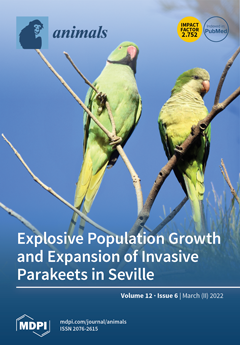Neospora caninum is recognized as a major cause of abortion in cattle, determining economic losses, particularly in dairy industries. To evaluate the impact of neosporosis on herd efficiency, and to understand how the serological analysis for
N. caninum is explicative of the farm
[...] Read more.
Neospora caninum is recognized as a major cause of abortion in cattle, determining economic losses, particularly in dairy industries. To evaluate the impact of neosporosis on herd efficiency, and to understand how the serological analysis for
N. caninum is explicative of the farm picture, an epidemiological study was designed in two dairy farms recruited as a case study. Blood samples were collected from 540 animals, including cows and heifers over 12 months, and analyzed by an indirect immunofluorescent antibody test with subsequent antibody titration. Overall, 94 animals (17.4%) were identified as positive to
N. caninum antibodies (15.5% and 18.5% in Farm 1 and Farm 2), with differences between the farms concerning the antibody titers (Chi-square,
p-value = 0.04), particularly in cows (Chi-square,
p-value = 0.018). Consequently, a different pattern of abortion episodes was depicted in the two investigated farms. Considering reproductive and productive performances, the number of inseminations necessary to make an animal pregnant was higher in seropositive cows (2.4 and 2.9 in Farm 1 and 2, respectively) than in seronegative ones (2.1 and 2.4 in Farm 1 and 2, respectively). Similarly, particularly in Farm 1, the number of days in milk of not-pregnant cows was higher in seropositive (167.7) than seronegative animals (133.4). Moreover, although the association between
N. caninum infection and milk production is still unclear, both the daily milk production and the 305-mature equivalent milk yield were lower in seropositive (31.02 and 11,838.94) than seronegative cows (33.59 and 12,274.88) in Farm 1; an opposite pattern was otherwise depicted in Farm 2. The study showed that even if
N. caninum circulated equally in the two herds, the dynamics of the parasite infection and its outcome may be different, also depending on the specific situation of the farm. In this way, the integration of serological analysis for
N. caninum, the reproductive and productive parameters, and the information on herd performances, could give specific indications for the application of control strategies.
Full article






